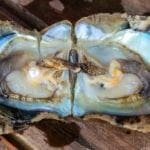Pearls that occur in nature happen when an irritant enters beneath a mollusk’s shell, causing the creature to cover it in a layer of nacre, which hardens over time, eventually becoming a jewel. This event is rare and the result is very costly. The same event can occur, but with human intervention. When pearls are created under controlled conditions, where the irritant is inserted specifically for the purpose of pearl-creation, this is a cultured pearl, which is usually more affordable. Fresh water pearls are less rare than their salt-water counterparts, which also makes them less exorbitant on the price scale.
Beyond harvest locality and means of creation, there are other means of separating the best pearls and the most costly from those that are less so. Perfectly round pearls are rare and often more expensive. Colors and shapes can be a matter of taste. But, a pearl with few flaws and excellent luster can command a high price.
Many highly valued pearls hail from Asia and Polynesia and have attributes that are specific to their region. Be careful in asking what you want as terminology can be misleading. Tahitian and Tahitian black, for example, can refer to a hue and not the region. Man-made options for those seeking a pearl look without the price tag can be found too, generally made from mother of pearl or from glass.
Key Takeaways:
- The author’s rule one is: “Know what you’re buying.” Her rule two is: “Buy what you like.”
- Pearls are created by mollusks. They can be created naturally or with the intervention of pearl harvesters.
- Saltwater pearls are usually grown in Asia, SouthEast Asia and Oceania while freshwater pearls are usually cultivated in China.
“In life, as in Econ 101, price depends on rarity, and most saltwater mollusks produce fewer pearls per harvest than freshwater mollusks.”
Read more: https://corporette.com/pearl-guide/











